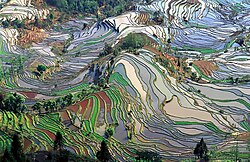Terrace farming
Terrace farming (also called step farming) is a method of farming that consists of different "steps" or terraces that were developed in various places around the world. The rice terraces of the Philippine Cordilleras are an example and are considered a World Heritage Site.[1]
This method of farming uses "steps" that are built into the side of a mountain or hill. On each level, various crops are planted. When it rains, instead of washing away all of the nutrients in the soil, the nutrients are carried down to the next level. These steps prevent water from washing away the soil and plants.[2] This system also allowed them to build aqueducts, which carried water to each level.
The idea was also independently developed by the Inca people. The Incas built their aqueduct system so well that it is still used today.
Terrace Farming Media
Terraced fields in the Jabal Haraz region of Yemen.
Rice terraces of the Hani people in Yunnan, China.
Rice terrace in the Fukuoka Prefecture, Japan.
Farmers working on rice terraces (Indonesia)
Terraced fields in La Gomera, Canary Islands
Terraces near Ein Karem, Israel
Cultivation terraces, Walkerburn
Rice terraces in Hoang Su Phi, Ha Giang, Vietnam.
References
- ↑ "World Heritage List". UNESCO. Retrieved 2012-09-22.
- ↑ Rolland Z. Wheaton; Edwin J Monke. "Terracing as a `Best Management Practice' for Controlling Erosion and Protecting Water Quality". Purdue University. Retrieved January 27, 2021.
- Terrace Farming: A unique agricultural solution. Social Studies for Kids. Web. 11 Apr. 2011.
Other websites
| Wikimedia Commons has media related to Lua error in Module:Commons_link at line 62: attempt to index field 'wikibase' (a nil value).. |









